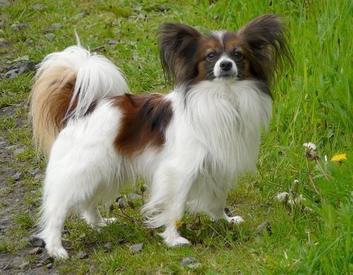
Dating back over 700 years, the Papillon is native to Italy and is widely depicted in Renaissance portraiture, usually in the laps of noblewomen or in the royal courts of France and Spain. The Papillion, meaning 'butterfly' in French due to its distinctive feathered ears and fringed face was a favoured breed of Louis XIV who kept many Papillons in his royal household. Sadly, due to their association with the aristocracy, many Papillons were slaughtered during the French Revolution, reducing their numbers significantly. It was purely due to careful breeding that the Papillon did not face extinction. Thought to descend from the English Toy and Cavalier King Charles Spaniels, the Papillon was first recognised by the American Kennel Club in 1915.
A small, graceful breed, the Papillon derives its name from its butterfly-like appearance, with a rounded forehead and pointed, fringed ears. The Papillon is further characterised by a high-set tail, short legs and a single coat with frills on the tail, back of the legs and chest. The coat is commonly coloured white with markings of any permissible colour, and with a dark mask over the eyes and ears. Its portable size makes the Papillon well suited to apartment life, while allowing it to be transported easily. Although the upright-eared Papillon is the more popular variety of the breed, there is another variety, the Phalene, or 'moth' dog, which possesses drop-ears similar to the Spaniel.
Contrary to common belief, the Papillon is highly trainable, providing it is shown firm leadership and early socialisation. If the breed is not consistently trained and socialised, it is likely to display reserved, fearful or aggressive tendencies towards strangers and other animals. Highly energetic and well engaged, the Papillon makes a great breed choice for active families, providing that children recognise its need for space and careful petting. Otherwise the Papillon is vigilant to threat and change, making a suitable watch dog, and has the potential to be a loyal and affectionate companion dog. On average, a healthy Papillon will weigh 3-5 kg with a long life expectancy of 15 years, although it is not uncommon for a Papillon to live well into its 20's.
Typically healthy and long-lived, the Papillon is susceptible to various health complaints, ranging from mild to more serious. These include orthopedic problems such as hip dysplasia and luxating patellar, as well as respiratory difficulties and collapsing trachea. Additionally, the Papillon is prone to allergies, seizures and dental disease. 'Small-Dog Syndrome' and associated behavioural issues are commonly identified in the breed, hence the need for early training.








From Flintshire, United Kingdom
A very loving and gentle dog easy to train very intelligent easy to groom pick up and go anywhere dog loves long or short walks and completely devoted to its owners what more could you want from a beautiful breed
and not to forget those butterfly ears